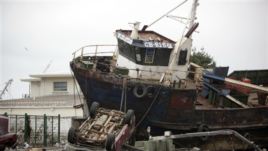21 May, 2012
BARBARA KLEIN: This is SCIENCE IN THE NEWS, in VOA Special English. I'm Barbara Klein.
BOB DOUGHTY: And I'm Bob Doughty. Today, we tell about some unexpected effects of a natural disaster. We also tell about an American intelligence report on water-related problems. And we tell about maps that may offer hope for dry areas in Africa.
(MUSIC)
BARBARA KLEIN: Scientists have reported that sandy beaches, their tiny organisms and plants were lost or harmed after recent natural disasters in Chile. But some of the coastal areas showed an unexpected recovery.

Chile's central coast was hit with an 8.8 magnitude earthquake followed by a tsunami in March 2010
By chance, the scientists had been studying nine Chilean sandy beaches in January of twenty ten. A month later, an eight-point-eight earthquake struck. Tsunami waves followed the earthquake. The scientists returned to the beaches soon after both events. Since then, they have worked there many times.
BOB DOUGHTY: Scientists from two continents recently reported on the conditions that helped decide if a beach would be harmed or survive. The journal PLoS ONE published a report from the research team. Its members are from the Universidad Austral de Chile and the University of California, Santa Barbara in the United States.
The researchers found that a beach's future was affected, in part, by the kind of shoreline, or coast, it had. Another influence was the direction and the amount of land level change caused by the disasters. Still another was how much humans had changed the beaches.
The researchers say the changes made by natural disasters are important and seem lasting. Their paper also documents problems caused by the rise of sea levels. That is a major sign of climate change.
BARBARA KLEIN: Before the earthquake, some beaches had sea walls or rocky emplacements – hard material to defend against big waves. This process, called armoring, can reduce the size of the beach area and kill beach life. But, the researchers were surprised by what happened to armored sandy beaches that were raised by the tsunamis. These beaches quickly developed new, welcoming environments for living organisms.
Jenifer Dugan of U.C. Santa Barbara's Marine Science Institute says people often think of earthquakes as causing total destruction. And, adding a tsunami is deadly for an ecosystem – its creatures, areas where they reproduce, and other living resources.
BOB DOUGHTY: As expected, research biologist Dugan said the researchers saw dead creatures on beaches and rocky shorelines. But she described the recovery of some of the sandy beaches as "remarkable." Still, she said, armoring itself covers up beaches, killing the habitat. She said this causes loss of ecosystem diversity – differing kinds of plant and animal life, including birds.
Eduardo Jaramillo was lead writer of the report. The zoology expert notes the importance of sandy beaches. He says they form about eighty percent of open coastlines worldwide. In his words, "sandy beaches are very good barriers against the sea level rise we are seeing around the world."
(MUSIC)
BARBARA KLEIN: An American intelligence report says water-related problems will likely increase tensions around the world in the next ten years. These problems include water shortages, poor water quality and floods.
The report says the problems will increase the risk of instability and the failure of governments. However, countries are seen as unlikely to go to war over water. The report says water tensions have historically led to more water-sharing agreements than violent conflicts.
But beyond ten years, it warns that some governments could use water as a weapon to pressure others. And water could also be used to "further terrorist objectives."
BOB DOUGHTY: The report is called an Intelligence Community Assessment on Global Water Security. It looks at possible effects of water problems on United States national security interests over the next thirty years. It says the areas that will be most affected by water problems are North Africa, the Middle East and South Asia.
Secretary of State Hillary Clinton released the report on March twenty-second -- World Water Day. The National Intelligence Council wrote the report based on a National Intelligence Estimate she requested a year ago.
HILLARY CLINTON: "Reliable access to water is essential for feeding the hungry, running the industries that promote jobs, generating the energy that fuels national growth, and certainly it is central when we think about how climate change will affect future generations."
BARBARA KLEIN: The report says water-related problems could distract countries from working with the United States on important policy goals. But it also predicts an increased demand for American aid and expert help to solve those problems.
The report says, "Water shortages, poor water quality, and floods by themselves are unlikely to result in state failure." But these could combine with poverty, social tensions, environmental problems, poor leadership and weak governments to produce social disorder. And that combination could cause state failure.
BOB DOUGHTY: The report predicts that from now through twenty forty, "water shortages and pollution probably will harm the economic performance of important trading partners." During the next ten years, it says, the loss of groundwater supplies in some agricultural areas will create a risk to national and global food markets.
Agriculture uses about seventy percent of the world's freshwater. The report says technology that reduces the amount of water needed to grow crops will offer the best defense against shortages.
(MUSIC)
BARBARA KLEIN: Millions of people in Africa do not have enough safe drinking water. And crops in many places suffer from lack of irrigation. Only about five percent of African farms use water from pipes, streams or ditches. But now, maps made by researchers in Britain have brought welcome news. Large amounts of groundwater appear to be under the African continent.
Groundwater remains after rain and melting snow run into streams and other waterways. The water is stored in layers of rock or bedrock under the soil, known as aquifers. Scientists say the aquifers hold an estimated one hundred times the water found on the continent's surface.
BOB DOUGHTY: A team from the British Geological Survey and University College London created the new maps. The research team based its work on other maps provided by national governments. The researchers used more than two hundred eighty studies of aquifers. Their report appeared in the journal Environmental Research Letters.
The new maps show that the countries with the most groundwater are in North Africa. They include Libya, Algeria, Egypt and Sudan. And, the researchers say countries now judged to lack water could be on top of deep groundwater.
Helen Bonsor was a writer of the report. She says the maps showing groundwater offer hope for better living conditions.
HELEN BONSOR: "It is a huge resource sitting there. And this work demonstrates that if it is managed appropriately, and with proper governance and technology to access the resource, it could alleviate water poverty, which millions in Africa suffer from."
BARBARA KLEIN: Ms. Bonsor has another piece of good news. She says that even in areas with little rainfall, the groundwater should last for between twenty and seventy years. She adds that, until now, there was not much information about groundwater available.
Richard Taylor of University College London was part of the team. He says the additional resources may help to control the amount of moisture, or water levels, in the soil.
RICHARD TAYLOR: "What we are saying here really is that there are quite considerable groundwater resources in Africa that might help to regulate soil moisture and, therefore, food security."
BOB DOUGHTY: But the researchers are not urging widespread exploration with boreholes. They say a good understanding of local groundwater conditions is needed first. And, they say the process needs to be careful and methodical.
If groundwater in Africa can be put to use, experts say, it could make the future brighter for millions of people. The World Health Organization, for example, says demand for water is growing as population increases. People are moving to cities, and industry is growing.
BARBARA KLEIN: Medical experts say lack of water threatens serious health risks. Drinking and watering crops with polluted water can cause disease. And polluted water stored in homes can appeal to insects that carry diseases.
Helen Bonsor points to the example of people who lack good water sources. She says they must spend valuable time looking for it. And that time could be better used for going to school, growing more crops or working at paying jobs.
(MUSIC)
BOB DOUGHTY: This SCIENCE IN THE NEWS was written by Jerilyn Watson, and produced by June Simms. I'm Bob Doughty.
BARBARA KLEIN: And I'm Barbara Klein. Join us again next week for more news about science in Special English on the Voice of America.









